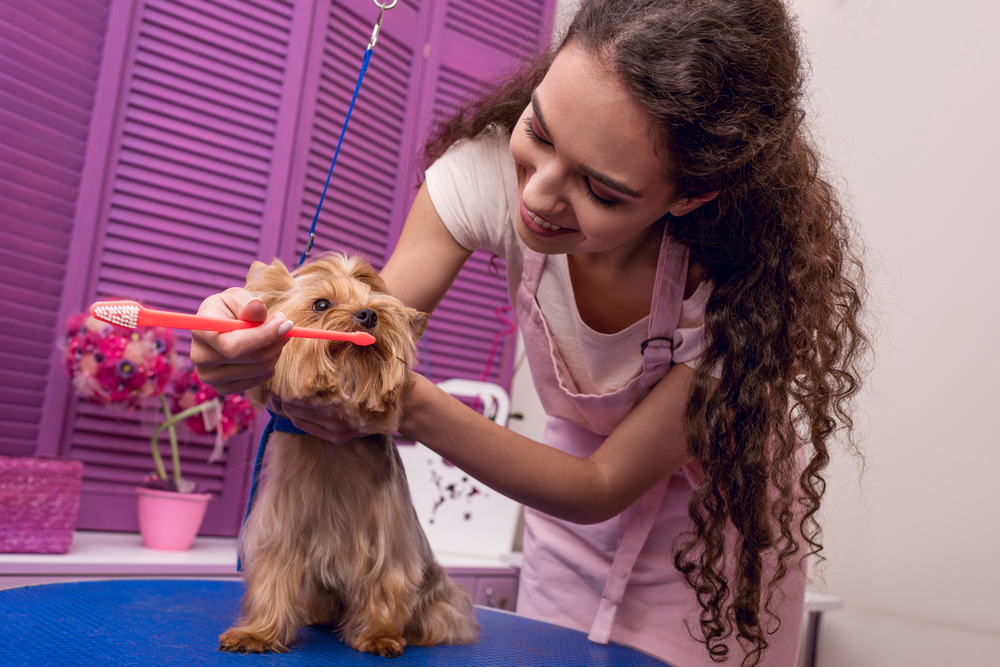
Keep your dog’s teeth healthy with regular dental checkups
Read Time: 4 minutes
Does your pet have bad breath? It might be a sign of hidden dental problems or the need for a dental cleaning performed by a veterinary professional. To keep your pet’s teeth in check between annual exams you can use dog-specific toothbrushes and toothpaste, dental treats and bones, chew toys, and water additives. But, even when using these extra measures, prepare to have your dog’s teeth professionally cleaned. You’ll likely need to have your dog’s teeth cleaned more often if they are a small dog breed due to crowding in the mouth or if they are a senior canine.
Techniques for Keeping Your Dog’s Mouth Clean
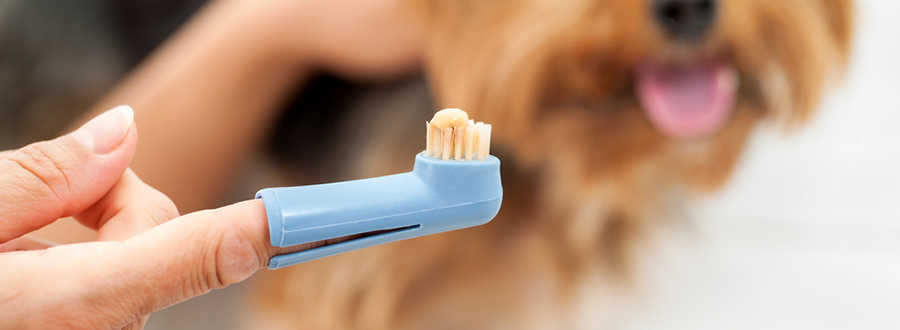
The main techniques for keeping your dog’s mouth clean are by brushing, using dental treats, and having your veterinarian perform dental cleanings as needed. There are also a handful of supplemental teeth cleaning options for maintaining your dog’s oral hygiene. These options include tooth wipes, chew toys, dental bones, and water additives.
Preventative dental care for dogs costs a fraction of the price tag on treating tooth-related diseases. This realization has shown a spike in dental care-related spending by pet owners. And with 8 in 10 dogs showing signs of oral disease by their third birthday, it makes sense to put in the upfront effort to maintain your dog’s oral health.
Brushing Your Dog’s Teeth
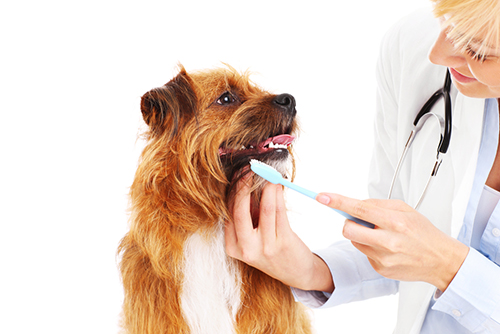
While 76% of pet owners agree that oral hygiene is important for overall health in their canine companions, only 10% brush their dog’s teeth at least once weekly. But brushing your dog’s teeth is the most effective way for you to fend off plaque before it turns into tartar, a process that takes 24 to 48 hours.
How to Brush Your Dog’s Teeth
You’ll want to use a dog-specific toothbrush. If you can’t locate one made for dogs, try a soft-bristled child’s toothbrush or a finger toothbrush. You’ll pair this with dog-specific toothpaste. Never use toothpaste meant for people. Baking soda and salt should also never be used as dog toothpaste-supplements as they can be harmful to your dog. Plus, your dog will be more receptive to dog toothpaste which is usually flavored to taste like poultry or another dog-approved taste.
#1
Position yourself non-threateningly
To begin the toothbrushing process, kneel or sit by your dog’s head. You don’t want to crowd or restrain your pet. This will only make them fearful and associate toothbrushing with being held down.
#2
Start by getting your dog used to light pressure on their teeth and gums
If you’ve never brushed your dog’s teeth or handled their mouth, start by rubbing your finger along their teeth and gum line. This is to help your dog become familiar with have their teeth touched. Don’t be surprised if your pup isn’t a huge fan of this. If they are especially resistant, try slowly warming them up to have you touch their teeth over multiple brushing sessions before ever using the toothbrush.
#3
Allow your dog to taste the dog toothpaste
Once your dog has accepted having their teeth touched by you, let them test out the taste of the dog toothpaste. If they aren’t a fan of the type you’ve picked out you can test out different flavors and brands until you find one they enjoy.
#4
Begin brushing, being careful not to apply too much pressure
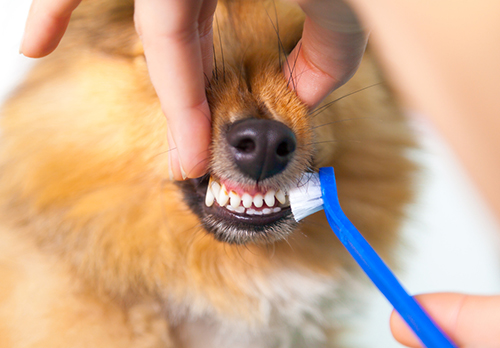
Now it’s time to begin brushing. Gently place the toothbrush at a 45-degree angle of the gumline. This will better clear away plaque than placing the toothbrush flat against the tooth. Use gentle circular motions across all top and bottom teeth. Throughout the process, be gentle, reassuring, and always end with a treat and praise.
Tip
Try to brush their teeth every few days or once a week.
Note: Some bleeding may occur during this process. Monitor the status of bleeding to ensure it is not severe. While minor bleeding is normal, severe bleeding could be a sign your dog is developing periodontitis. If major bleeding occurs contact your pet’s vet as soon as possible.
Need your dog’s teeth cleaned?
Toothwipes as Alternatives to Toothbrushes
If your dog says no way to toothbrushes, you might be able to get away with using toothwipes. These premoistened wipes can be used daily to wipe the surface of the teeth. Toothwipes are textured specifically for use on dog’s teeth to clean but not damage gums. They are convenient and quick to use with no need for rinsing.
Offering Dental Treats to Your Dog
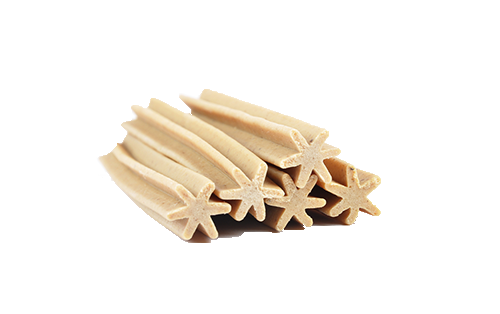
Dental treats are lining pet store shelves and they can be great, convenient ways to slip in an extra oral health-conscious decision into your dog’s everyday life. Some dog dental treats on the market today can reduce your dog’s plaque by up to 70%. This is achieved by larger diameter treats with a coating called polyphosphate. The Veterinary Oral Health Council (VOHL) gives its seal of approval on products able to reduce plaque by 10% to 20% depending on the specific uses. A full list of products that received their seal of approval can be found here.
But even with a better doggy smile in order, you’ll want to limit the number of dental treats your dog receives. You don’t want to trade out dental problems for weight problems.
Chew Toys, Bones, and Diets for Dental Cleaning
If you’re trying to watch your dog’s weight, there are other ‘fun’ ways to practice oral hygiene with your pup.
Chew toys and bones give your dog something to gnaw on that will work at the buildup on his teeth and in the crevices of his teeth. This helps to kick plaque to the curb before it hardens and becomes tartar. You can also opt for a dental-specific diet to replace his current kibble. But check with your vet before you make the switch. They’ll be able to guide you to the best brand for real results.
While dental treats, chew toys, bones, and dental health-specific diets can all help to improve your dog’s oral hygiene, it can’t replace brushing and professional cleaning. These products can clean the surface of your dog’s mouth, but they aren’t able to clean under the gumline. This is where plaque really gets established and starts wreaking havoc. So while these dental hygiene options are beneficial, they shouldn’t be the only measure you take to ensure your dog has a healthy mouth.
Cleanings by Your Veterinarian
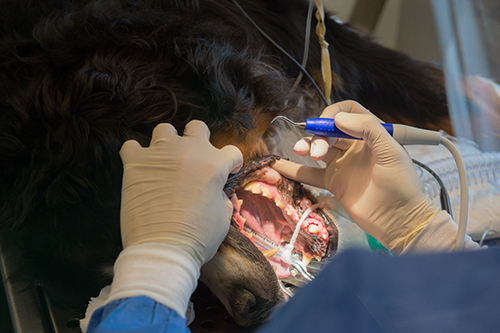
While you can practice every other method of canine dental hygiene, professional dental cleanings shouldn’t be skipped out on. Your veterinarian and their trained staff will remove tartar and make any necessary teeth extractions to get your dog’s mouth back to tip-top condition.
You should prepare for professional dental cleaning once a year. But speak with your vet to develop the best plan for your pup. Some dogs may be able to wait longer between cleaning while some may need them more frequently.
How Often Should Your Dog’s Teeth Be Cleaned?
Professional cleanings once per year is recommended by most veterinary professionals. However, your veterinarian will assess your dog and determine the best treatment plan for your pet.
Your pet may need more frequent cleanings if they are older, have advanced dental problems, or are a small dog breed. Small dog breeds are notorious for their bad teeth. This is caused by their mouths being smaller and becoming overcrowded. Their overcrowded teeth are then more susceptible to periodontal disease.
What Does a Healthy Dog Mouth Look Like?
If you take a peek into your dog’s mouth you can potentially spot developing problems before they worsen. Healthy dog gums are pink or mottled. Their gums shouldn’t be red, swollen, or oozing. Also keep an eye out for pale pink, white, blue and purple gums. Basically, if they’re not a healthy pink, it’s time to call your vet.
While your dog’s breath will never revert to its puppy breath stage, you can still spot a rising oral health problem. If your dog’s breath is particularly pungent they may have a dental disease.
Healthy dog mouths will not have any broken teeth or obvious, significant plaque buildup around the gumline.
Common Dental Problems to Watch For

Knowing what to look for and what can happen to a dog with unmaintained oral hygiene can help dog owners stay on top of keeping their dog’s mouth properly managed. Here are the most common canine dental problems to watch out for.
Cysts
Sometimes lumps and bumps will form in your dog’s mouth. While these might be nothing to worry about, you’d rather be safe than sorry. Have your vet check to see if the newly-formed bump is a tumor or cyst.
If it’s a cyst, your vet may need to drain it. If it’s a tumor, your vet will likely suggest it be biopsied to determine whether it is cancerous or not.
What it looks like: Raised lumps on your dog’s gums. Will likely be one solitary lump.
Halitosis
Halitosis, otherwise known as bad breath, is caused by bacterial buildup in the mouth. While you should start brushing your dog’s teeth more regularly, it doesn’t hurt to have your dog examined by their vet. Halitosis sometimes points to an underlying infection or kidney disease.
What it looks like: You’ll smell it rather than see it. It will be more intense than normal ‘doggy breath’.
Plaque

Plaque is the dark brown or yellowish buildup on your dog’s teeth. It will likely be concentrated around the gumline. Plaque will turn into tartar within 24 to 48 hours. At which point you won’t be able to simply brush it away.
If you notice an increase in plaque or tartar buildup on your dog’s teeth, it may be time for a professional cleaning. Contact your veterinarian for an exam to determine if and when your dog will need to be scheduled for a dental exam.
What it looks like: Dark brown or yellow buildup on dog’s teeth, concentrated around the gumline.
Proliferating Gum Disease
Proliferating gum disease occurs when the gums begin to grow over the teeth. Dogs with proliferating gum disease are more susceptible to developing infections.
What it looks like: Gums growing over teeth, more common in boxers and bull terriers.
Gingivitis

Dogs develop gingivitis just like people. Luckily, you can reverse this dental condition with a change in your pet’s oral hygiene habits. Begin brushing your dog’s teeth more often and making other small changes in favor of healthy teeth. Your veterinarian can help guide you in making the best decisions for your dog as you manage this dental condition.
What it looks like: Irritated gums and an excess of plaque.
Periodontal Disease
Dogs can begin to show signs of periodontitis as early as three years old. Given it’s the most common dental condition in dogs, you’ll want to take special precautionary measures to prevent your dog from developing it.
Dogs with periodontal disease will experience pain, loosening teeth, irritated and swollen gums, and in severe cases, nasal discharge.
Book an appointment with your veterinarian at the first sign of your dog developing periodontal disease. Your veterinarian will be able to develop a treatment plan to help manage your dog’s condition.
What it looks like: Yellowing or brown teeth, loss of appetite or difficulty eating, and irritated gums are all signs of periodontal disease.
Signs You Need to Take Your Dog to the Vet
If your pet is up-to-date on his exams but is exhibiting any of the following symptoms, contact your vet to have his teeth checked:
- Bad or worsening breath
- Buildup of plaque along the gumline
- Swollen and bleeding gums
- Loss of appetite
- Excessive drooling
- Pawing or scratching at their mouths consistently
- Unexplained lumps or growths on the gums
- Broken and discolored teeth
You want to tackle dental problems before they progress. By contacting your veterinarian as soon as you become aware of your dog’s symptoms you are more likely to resolve the problem before it becomes a major problem for your dog’s comfort and your wallet.
If you haven’t had your pup’s teeth checked in the past year or longer, schedule an appointment to get them on the path to lifelong oral health.
Schedule Your Pet’s Dental Cleaning
Our team of veterinary experts can help restore your pet’s oral health.




